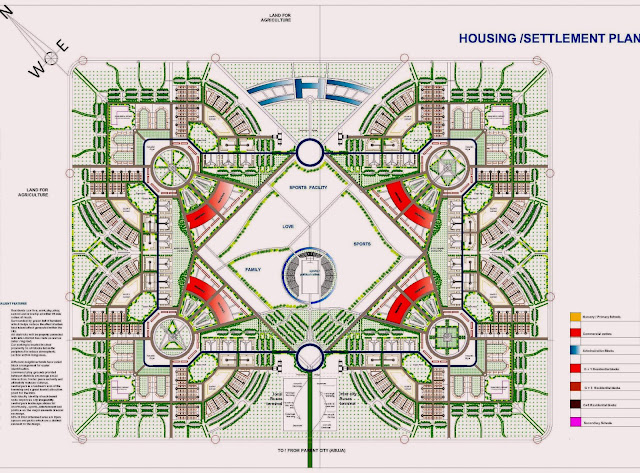 | |
| Residential layout of Abuja satellite township (Academic Proposal) |
The task of creating Sustainable Satellite Township for Abuja, Nigeria (academic proposal) is finally crystallized in design and policy form. Although yet an academic exercise by Nigerian-born, Indian- based Architect Kosi Emmanuel, it is expected that the research findings would be relevant in tackling the socioeconomic challenges facing the Nigerian capital city such as increasing population due to growing middle income workers as well as sky-rocketing house rents and security issues, to name but a few.
The design approach embraces social, economic and environmental sustainability. It's SALIENT FEATURES include;
· Phased development, having sustainable districts at each phase.(the plan provides for a ten year duration and is expected to cater for about 100,000 persons from population projections based on existing growth rate).
each district would have its own light industrial zone which can comfortably employ its residents.
· Residents can live, work, play, shop, school and worship all within 1/4 mile radius of reach.
· Surrounded by green belt of farmland which helps reduce the effect of urban heat island effect generated within the city.
· All districts will be properly connected with inter-district bus route as well as outer ring road.
· Car parking is located in close proximity to all blocks but on the peripheral to reduce atmospheric carbon within living areas.
· Different neighborhoods have varied block arrangement for easier identification.
· communal play grounds provided between districts encourage social interaction, foster peace and unity and ultimately reduces violence.
· central park is a landmark icon of the township and a great tourist attraction point for the town.
· individually identity of each transit node improves city imageability.
· central park landscape allows for love/family, sports, entertainment and politics as the major elements of social exchange.
· 65% of total Urbanized area are Open spaces and parks which are a distinct element in the design.
· elimination of the traitional grid iron pattern and its attendant thorough fare traffic
· and replacement with the super block model.
· provision of private as well as communal green spaces
· shared communal facilities encourage social interaction and are cheaper to maintain
· turn to alternative revenue sources
· carless community thus less carbon emmision
· cultural and promotion through football
· provision of well connected service roads and cycle and pedestran ways
· a fine blend of the garden city concept, and the neighbourhood planning concepts with le crbusiers city centralisedbusiness district model.
· Residents can live, work, play, shop, school and worship all within 1/4 mile radius of reach.
· Surrounded by green belt of farmland which helps reduce the effect of urban heat island effect generated within the city.
· All districts will be properly connected with inter-district bus route as well as outer ring road.
· Car parking is located in close proximity to all blocks but on the peripheral to reduce atmospheric carbon within living areas.
· Different neighborhoods have varied block arrangement for easier identification.
· communal play grounds provided between districts encourage social interaction, foster peace and unity and ultimately reduces violence.
· central park is a landmark icon of the township and a great tourist attraction point for the town.
· individually identity of each transit node improves city imageability.
· central park landscape allows for love/family, sports, entertainment and politics as the major elements of social exchange.
· 65% of total Urbanized area are Open spaces and parks which are a distinct element in the design.
· elimination of the traitional grid iron pattern and its attendant thorough fare traffic
· and replacement with the super block model.
· provision of private as well as communal green spaces
· shared communal facilities encourage social interaction and are cheaper to maintain
· turn to alternative revenue sources
· carless community thus less carbon emmision
· cultural and promotion through football
· provision of well connected service roads and cycle and pedestran ways
· a fine blend of the garden city concept, and the neighbourhood planning concepts with le crbusiers city centralisedbusiness district model.
· The maximum walking distance for pedestrian to every bus stop is 1/4 of a mile (400m) in 15 min indicated by circles in broken Lines.
· the entire town is surrounded by an outer ring road which is a four-lane bus and other vehicles route, which can also accommodate a metro line if need be, in future.
· Major Bus-stops are 1km apart, Metro stops are 2km apart.
· Green ways connect residences to outer ring road.
· Four major nodal points each have a distinct landscape pattern which add to city imageability.
· One could walk from one district to another around the city on foot, under shade.
· Pedestrian bridges are provided where foot path meets major road; to ensure pedestrians safety.
· the entire town is surrounded by an outer ring road which is a four-lane bus and other vehicles route, which can also accommodate a metro line if need be, in future.
· Major Bus-stops are 1km apart, Metro stops are 2km apart.
· Green ways connect residences to outer ring road.
· Four major nodal points each have a distinct landscape pattern which add to city imageability.
· One could walk from one district to another around the city on foot, under shade.
· Pedestrian bridges are provided where foot path meets major road; to ensure pedestrians safety.
More details will be available for your download and review soon.please feel free to contact the Architect of this modern solution to Abuja population overspill.

